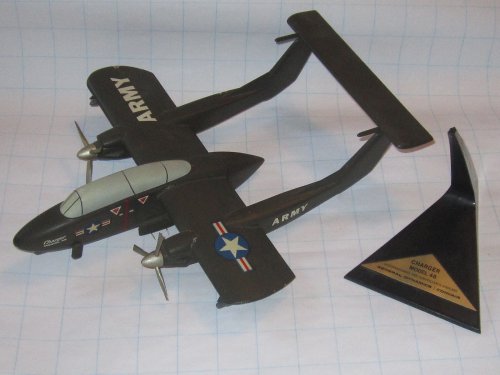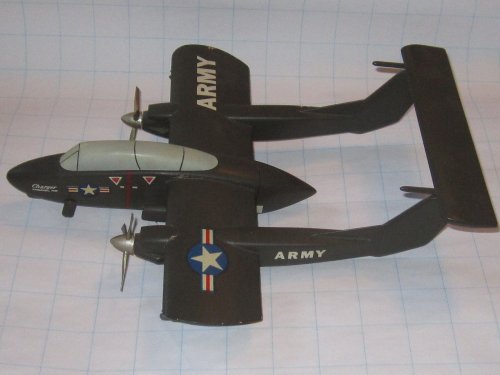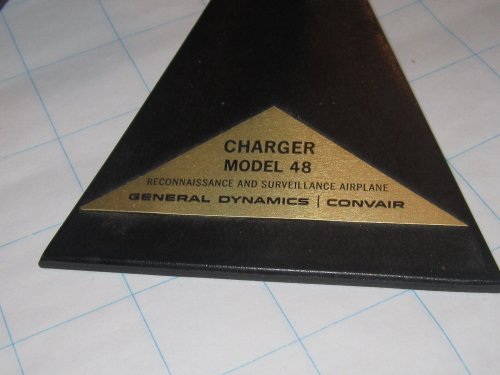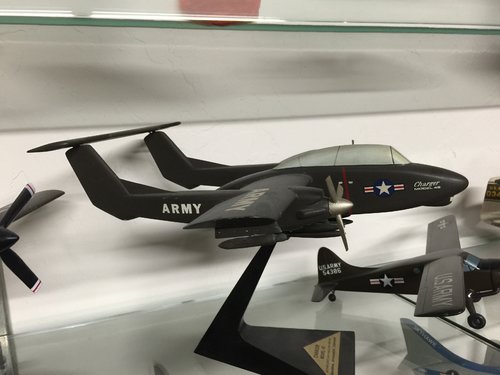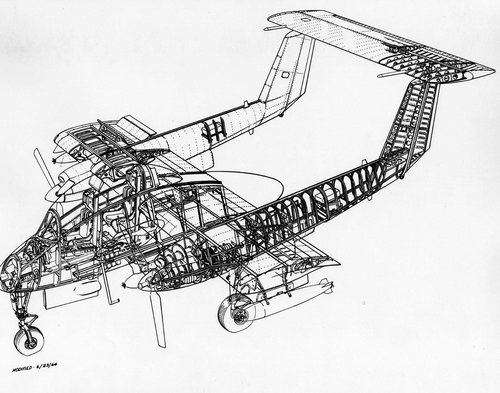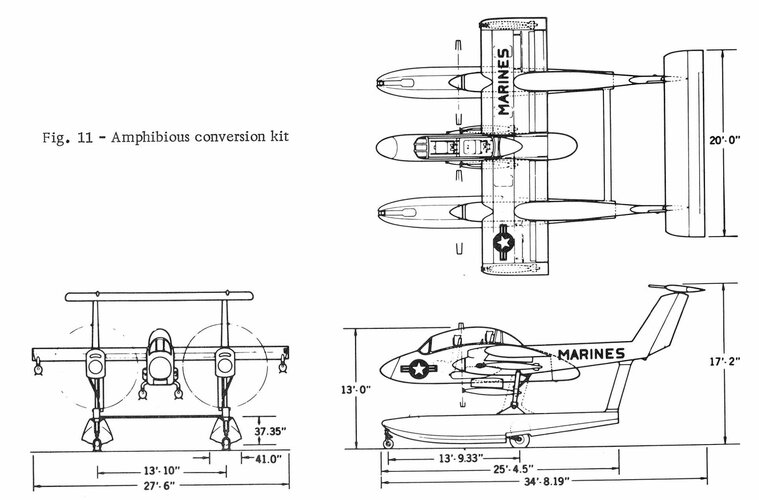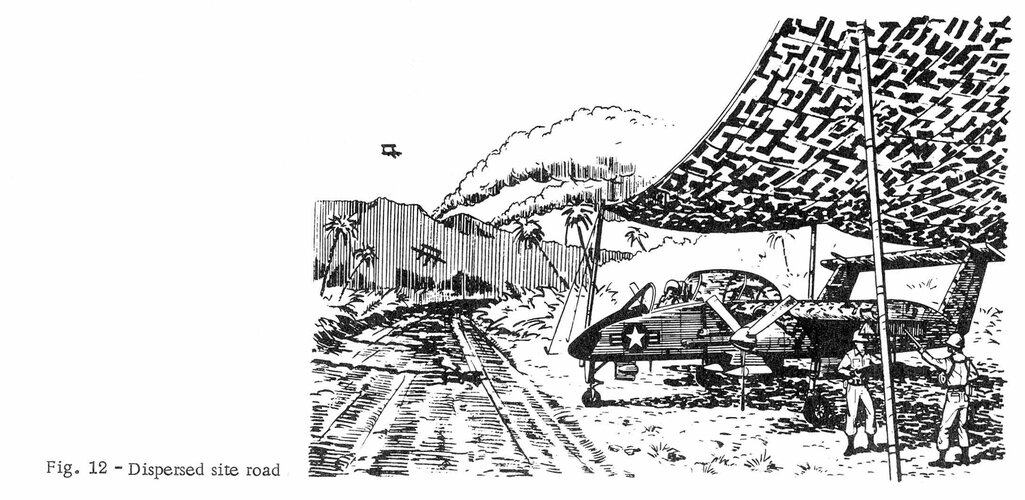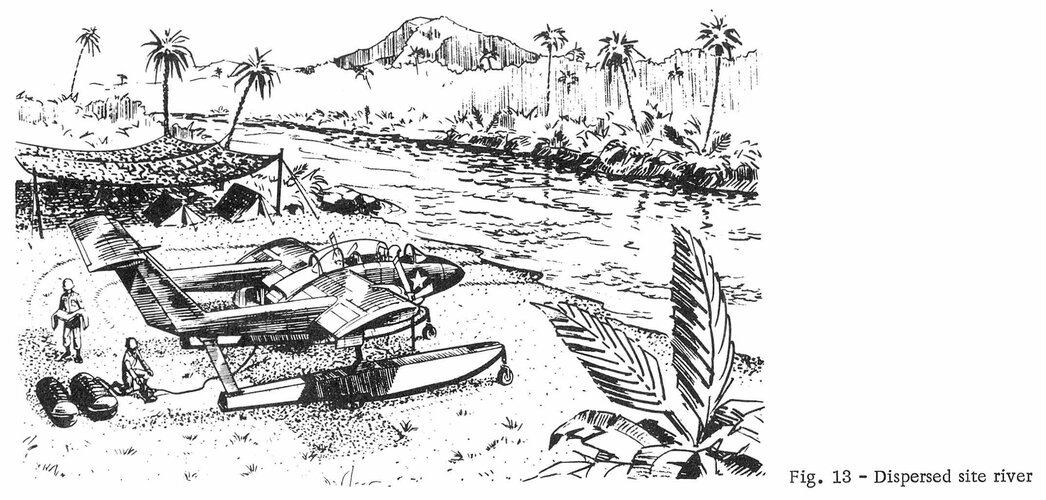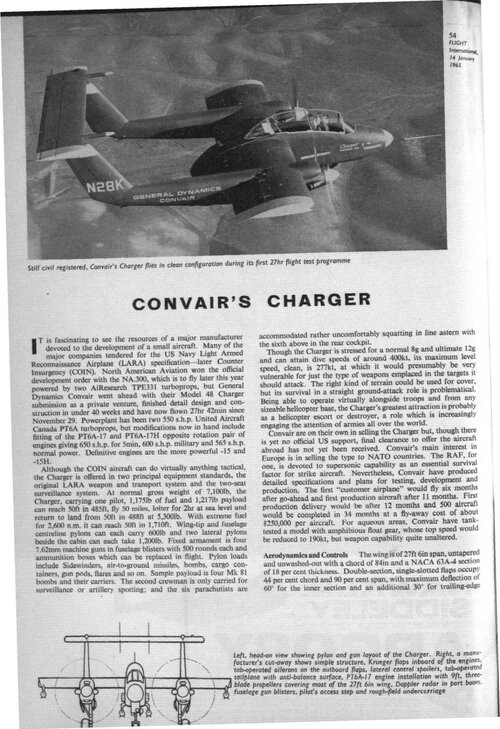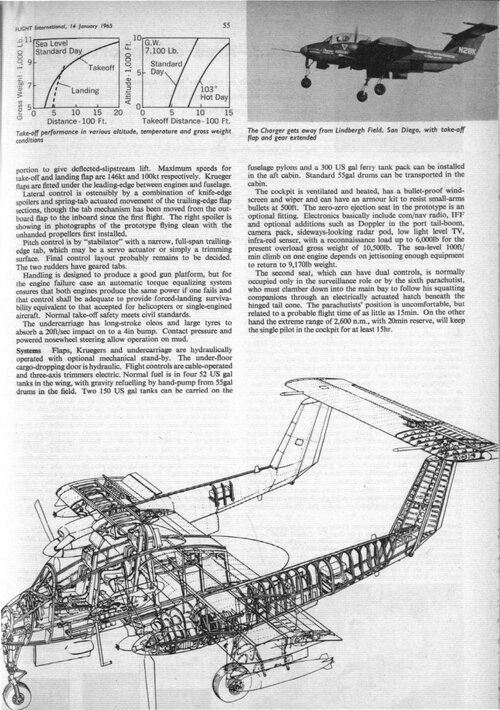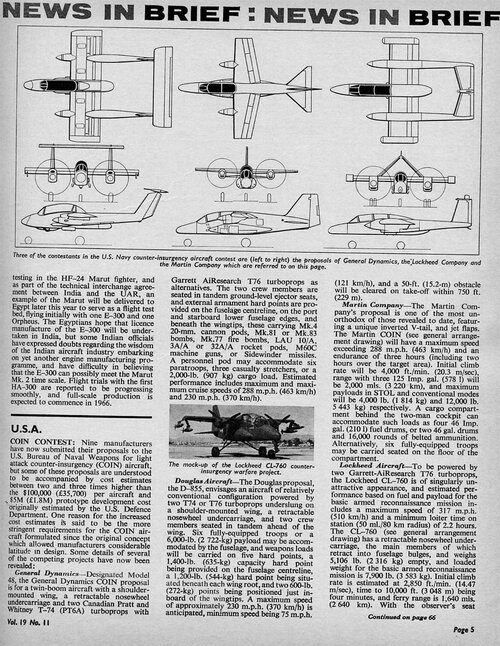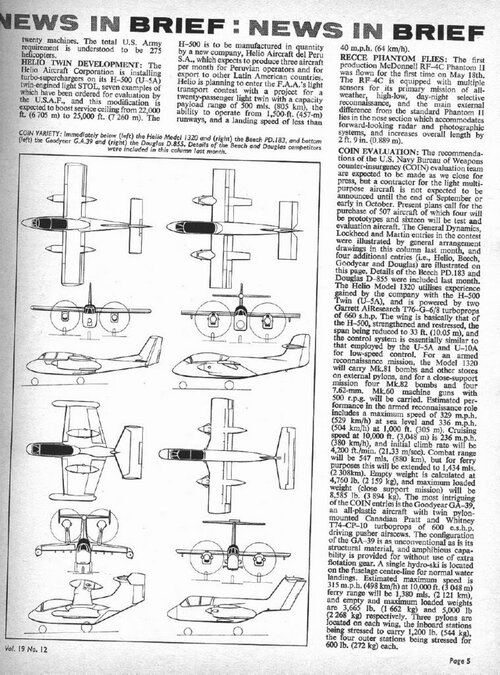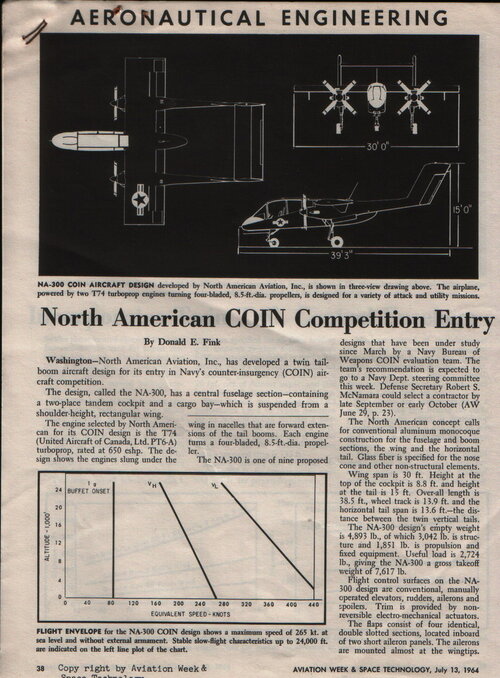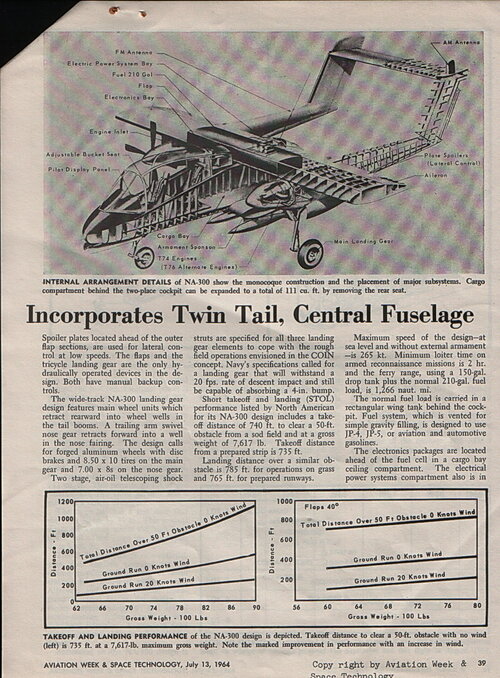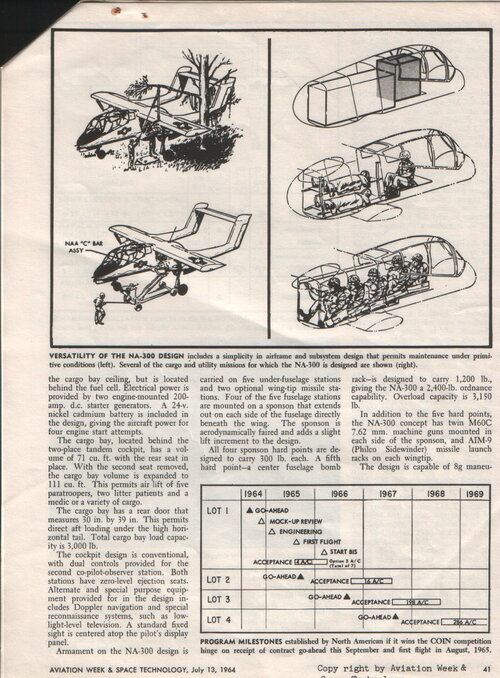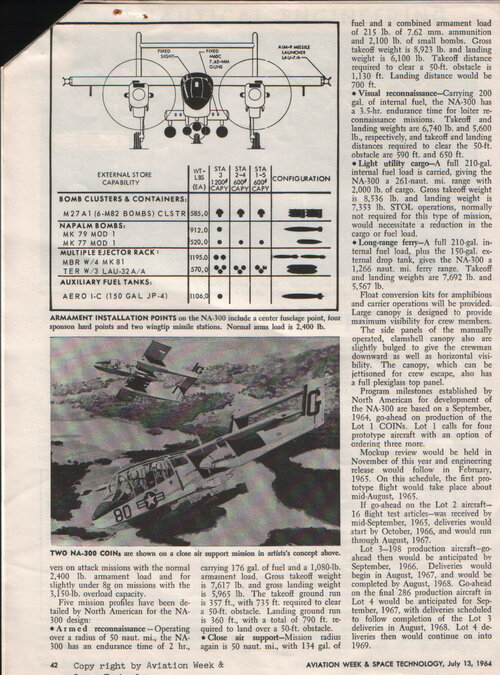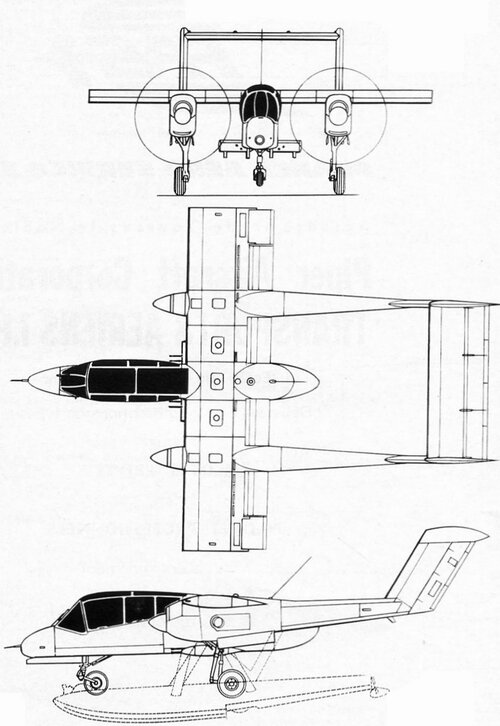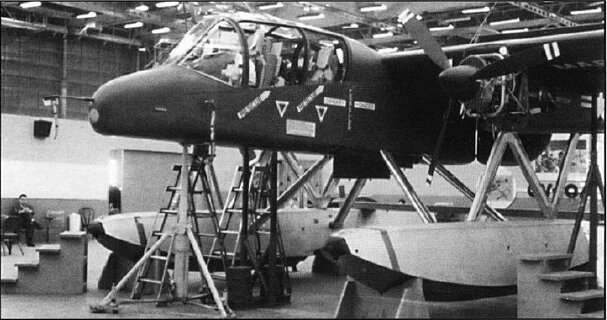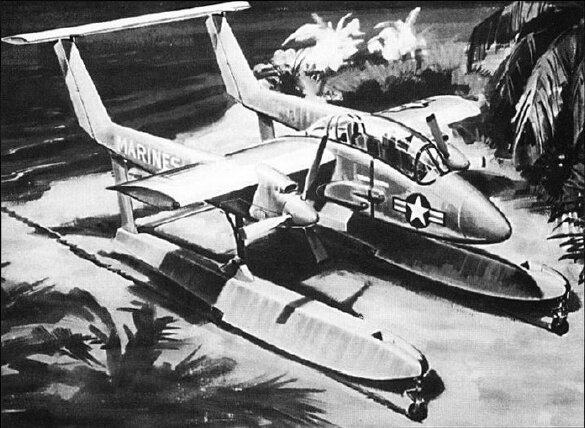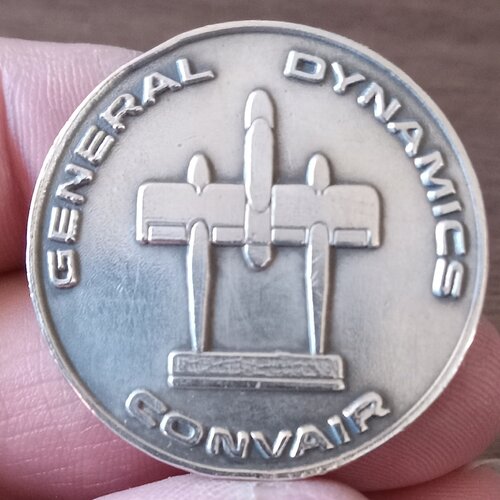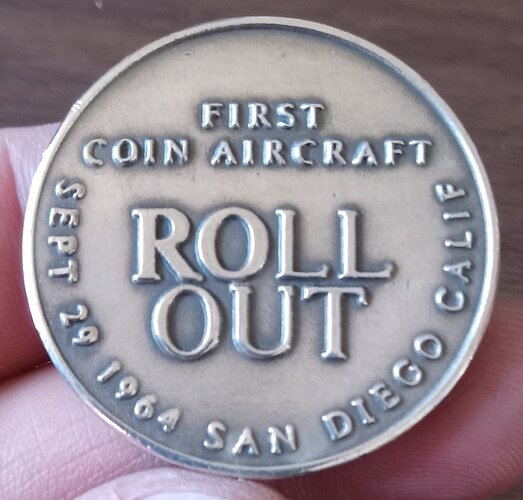You are using an out of date browser. It may not display this or other websites correctly.
You should upgrade or use an alternative browser.
You should upgrade or use an alternative browser.
Convair Model 48 Charger
- Thread starter Sferrin
- Start date
- Joined
- 25 June 2009
- Messages
- 14,758
- Reaction score
- 6,163
Wonderful! Thanks a lot for sharing this.
Despite being a great lover of the Bronco, I must say the Charger had amazing potential and great aesthetics too. Too bad it didn't get its chance.
It was also, I believe, the last new aircraft built under the name Convair (someone please correct me if I'm wrong). Even then the General Dynamics name was already painted on it and variously used instead of Convair.
The incredibly short landing run would have made it a great carrier-borne utility transport, for instance. It could also have served as a COIN type for foreign Armies.
Despite being a great lover of the Bronco, I must say the Charger had amazing potential and great aesthetics too. Too bad it didn't get its chance.
It was also, I believe, the last new aircraft built under the name Convair (someone please correct me if I'm wrong). Even then the General Dynamics name was already painted on it and variously used instead of Convair.
The incredibly short landing run would have made it a great carrier-borne utility transport, for instance. It could also have served as a COIN type for foreign Armies.
- Joined
- 13 June 2007
- Messages
- 2,173
- Reaction score
- 3,096
Hi All -
On EPay:
http://www.ebay.com/itm/Convair-Model-48-Charger-General-Dynamics-Prototype-Airplane-Desk-Model-US-Army-/301405456283?pt=LH_DefaultDomain_0&hash=item462d2a479b
Enjoy the Day! Mark
On EPay:
http://www.ebay.com/itm/Convair-Model-48-Charger-General-Dynamics-Prototype-Airplane-Desk-Model-US-Army-/301405456283?pt=LH_DefaultDomain_0&hash=item462d2a479b
Enjoy the Day! Mark
Attachments
Nice find.
Winning bid:
US $217.50
[ 10 bids ]
US $217.50
[ 10 bids ]
- Joined
- 3 June 2006
- Messages
- 3,094
- Reaction score
- 3,966
- Joined
- 31 July 2013
- Messages
- 573
- Reaction score
- 1,188
- Joined
- 13 August 2007
- Messages
- 8,463
- Reaction score
- 11,059
This book is definitely worth it for anyone interested in the Charger.

 bookshop.org
bookshop.org

Convair Model 48 Charger a book by Steve Ginter
For more than two years prior to the Navy issuing an RFP (Request for Proposal) in 1964, Convair engineers had been evaluating designs for use in the limited war and counter-insurgency arenas. These designs were evaluated by many military and civilian representatives of the armed forces and...
Huh? My understanding from the book I cited above among other sources was that COIN was the primary mission of the Charger concept, which eventually led to the adoption of the OV-10 Bronco.
Оne of the goals of the concept was guerrilla warfare but also support for infantry that will fight in Western Europe and Western part od U.S.A if they (soviets) succeed to somehow move across Alaska and Canada to West America with large Soviet mechanized units. And one of the reasons for the 106mm recoilless rifle on the Brоnco's hull was to get something like a nazi JU-87 dive bomber but to use recoilles rifle when airplane are diving , as some form of artillery support in the fight against tanks and bunkers.
- Joined
- 3 June 2006
- Messages
- 3,094
- Reaction score
- 3,966
Recently uploaded at the SDASM Archives on flickr and for me new pictures showing the General Dynamics/Convair Charger Model 48.
Link:
View: https://flic.kr/p/2kntLT9
View: https://flic.kr/p/2knydn6
_________________________________________
Also some pictures posted by Ron Downey on his blog.
Link:
View: https://flic.kr/p/2kntLT9
View: https://flic.kr/p/2knydn6
_________________________________________
Also some pictures posted by Ron Downey on his blog.
Source: http://aviationarchives.blogspot.com/2021/01/convair-model-48-charger-photos.htmlRon Downey said:
Last edited:
- Joined
- 27 December 2005
- Messages
- 17,753
- Reaction score
- 26,468
Very nice drawings! Note the short 27' wingspan on the Charger, though the revised model submitted to LARA had 30' wings. The OV-10 Bronco that we eventually got, which is still not a big aircraft, had a span of 40' so much less practical for the type of dispersed road use originally envisioned for both the COIN and conventional roles.
Tim treeborgsen
ACCESS: Restricted
- Joined
- 3 August 2021
- Messages
- 1
- Reaction score
- 0
Wonderful! Thanks a lot for sharing this.
Despite being a great lover of the Bronco, I must say the Charger had amazing potential and great aesthetics too. Too bad it didn't get its chance.
It was also, I believe, the last new aircraft built under the name Convair (someone please correct me if I'm wrong). Even then the General Dynamics name was already painted on it and variously used instead of Convair.
The incredibly short landing run would have made it a great carrier-borne utility transport, for instance. It could also have served as a COIN type for foreign Armies.
I am imagining it made from carbon fiber with a Kevlar lined cockpit!!
Where does one get engineering and a plan for it???!
Anyone have a key to the vault or know someone in the doc department at General Dynamics.
- Joined
- 3 October 2007
- Messages
- 1,960
- Reaction score
- 1,197
For the purposes for which this aircraft was intended, internal armor was not in the basic design, outside of the bullet proof canopy. In theory, additional armor could have been hung inside or outside, but there would be a weight and performance hit.Did this plane have armor
One of the advantages the Charger had over the OV-10 was that if you had to ditch you'd probably survive. Although some back seaters made it, no pilot of an OV-10 that had to ditch ever survived.
Last edited:
Colonial-Marine
UAVs are now friend, drones are the real enemy.
- Joined
- 5 October 2009
- Messages
- 1,475
- Reaction score
- 1,331
What about the OV-10's design made ditching such a particularly lethal prospect to the pilot?For the purposes for which this aircraft was intended, internal armor was not in the basic design, outside of the bullet proof canopy. In theory, additional armor could have been hung inside or outside, but there would be a weight and performance hit.Did this plane have armor
One of the advantages the Charger had over the OV-10 was that if you had to ditch you'd probably survive. Although some back seaters made it, no pilot of an OV-10 that had to ditch ever survived.
- Joined
- 18 June 2009
- Messages
- 1,412
- Reaction score
- 2,494
A reference here:
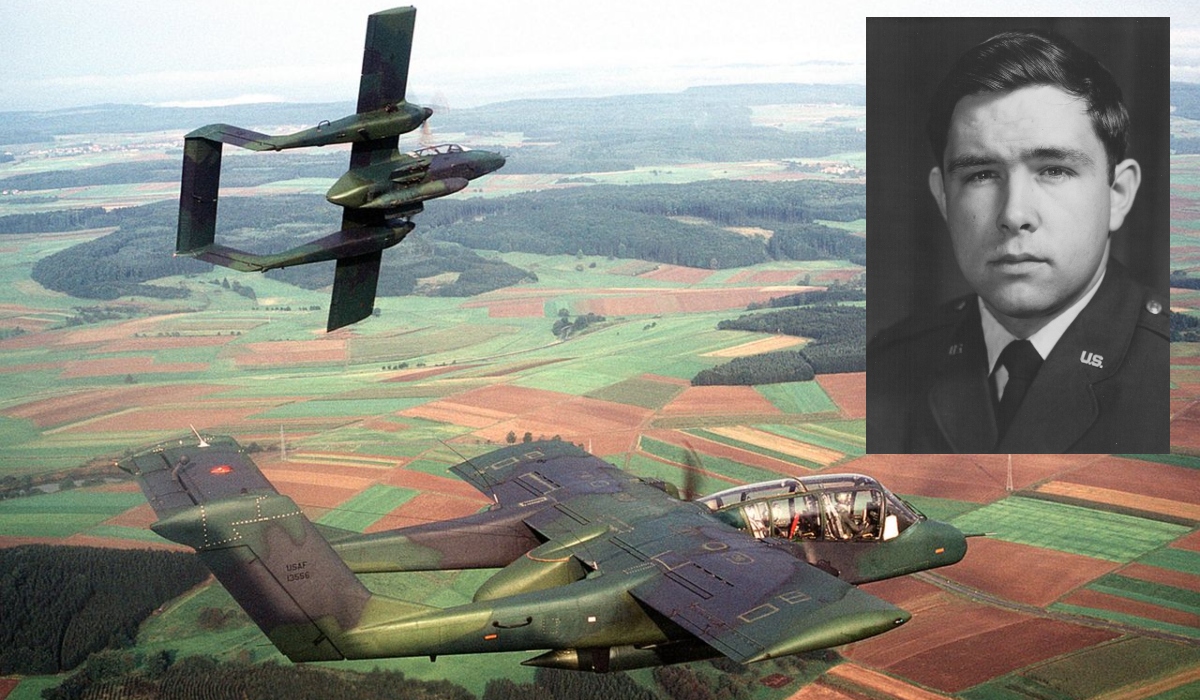
 theaviationgeekclub.com
theaviationgeekclub.com
"As the twin-boomed Bronco pulled up from its fifth attack, a missile rose up from behind and struck the plane’s left engine. The explosion set the engine on fire and knocked the left landing gear from its stowed position, leaving it hanging down. The canopies over the two airmen were pierced by fragments.
Captain Bennett veered southward to find a field for an emergency landing. As the fire in the engine continued to spread, he was urged by the pilot of an escorting OV-10 to eject. The wing was in danger of exploding. He then learned that his observer’s parachute had been shredded by fragments in the explosion.
Captain Bennett elected to ditch in the Gulf of Tonkin, although he knew that his cockpit area would very likely break up on impact. No pilot had ever survived an OV-10 ditching. As he touched down, the extended landing gear dug into the water. The Bronco spun to the left and flipped over nose down into the sea. His Marine companion managed to escape, but Captain Bennett, trapped in his smashed cockpit, sank with the plane. His body was recovered the next day.
For sacrificing his life, Captain Bennett was posthumously awarded the Medal of Honor. The decoration was presented to his widow by Vice President Gerald R. Ford Aug. 8, 1974."

This OV-10 pilot died after ditching his Bronco to save his observer who couldn’t eject because his parachute was shredded by the explosion of a North Vietnamese SA-7 - The Aviation Geek Club
This OV-10 pilot died after ditching his Bronco to save his observer who couldn’t eject because his parachute was shredded by the explosion of a North Vietnamese SA-7
"As the twin-boomed Bronco pulled up from its fifth attack, a missile rose up from behind and struck the plane’s left engine. The explosion set the engine on fire and knocked the left landing gear from its stowed position, leaving it hanging down. The canopies over the two airmen were pierced by fragments.
Captain Bennett veered southward to find a field for an emergency landing. As the fire in the engine continued to spread, he was urged by the pilot of an escorting OV-10 to eject. The wing was in danger of exploding. He then learned that his observer’s parachute had been shredded by fragments in the explosion.
Captain Bennett elected to ditch in the Gulf of Tonkin, although he knew that his cockpit area would very likely break up on impact. No pilot had ever survived an OV-10 ditching. As he touched down, the extended landing gear dug into the water. The Bronco spun to the left and flipped over nose down into the sea. His Marine companion managed to escape, but Captain Bennett, trapped in his smashed cockpit, sank with the plane. His body was recovered the next day.
For sacrificing his life, Captain Bennett was posthumously awarded the Medal of Honor. The decoration was presented to his widow by Vice President Gerald R. Ford Aug. 8, 1974."
- Joined
- 9 October 2009
- Messages
- 21,979
- Reaction score
- 13,647
- Joined
- 3 October 2007
- Messages
- 1,960
- Reaction score
- 1,197
I would surmise that the shape of the nose and location of the canopy were such that the water would come right up and smash through the windscreen in front, battering the pilot. Additionally, the cockpit of the OV-10 was below the wing. That meant when the aircraft came to rest in the water, even if it was temporarily floating, the cockpit was underwater. The Charger's nose looks like it would act as more of a waterbreak and the cockpit was mostly at or above wing level, giving the crew extra time to get out. Just my guess.What about the OV-10's design made ditching such a particularly lethal prospect to the pilot?For the purposes for which this aircraft was intended, internal armor was not in the basic design, outside of the bullet proof canopy. In theory, additional armor could have been hung inside or outside, but there would be a weight and performance hit.Did this plane have armor
One of the advantages the Charger had over the OV-10 was that if you had to ditch you'd probably survive. Although some back seaters made it, no pilot of an OV-10 that had to ditch ever survived.
I've had a couple of ocacassions to talk to pilots who fly the OV-10 for the California Department of Forestry and Fire Protection and they say they're briefed that if they have to ditch they probably won't make it out
That ditching issue with the Bronco is new to me. The story that Richard N. posted does make me wonder, though. Why would you ditch an aircraft with retractable gear with the gear down? "As he touched down, the extended landing gear dug into the water."
- Joined
- 18 June 2009
- Messages
- 1,412
- Reaction score
- 2,494
"As the twin-boomed Bronco pulled up from its fifth attack, a missile rose up from behind and struck the plane’s left engine. The explosion set the engine on fire and knocked the left landing gear from its stowed position, leaving it hanging down. The canopies over the two airmen were pierced by fragments."
Fair enough, I get that, but then why would it be the case that "No pilot had ever survived an OV-10 ditching"? Did no one ever ditch with the gear up? Was the issue in the gear mechanism or the hydraulic system rather than some fundamental flaw in fuselage structure?"The explosion set the engine on fire and knocked the left landing gear from its stowed position, leaving it hanging down."
- Joined
- 3 October 2007
- Messages
- 1,960
- Reaction score
- 1,197
I opined on the reasons for this a couple of posts back. Although in this particular case one of the gear was down, it doesn't seem that gear position made any difference to the ultimate outcomes. No front seater ever survived a ditching in an OV-10.Fair enough, I get that, but then why would it be the case that "No pilot had ever survived an OV-10 ditching"? Did no one ever ditch with the gear up? Was the issue in the gear mechanism or the hydraulic system rather than some fundamental flaw in fuselage structure?"The explosion set the engine on fire and knocked the left landing gear from its stowed position, leaving it hanging down."
apparition13
I really should change my personal text
- Joined
- 27 January 2017
- Messages
- 605
- Reaction score
- 1,107
This really is one of my favorite unproduced aircraft. Also worth mentioning is it's outstanding strategic range. With auxiliary fuel tanks it could transit the pacific to Vietnam in three hops; west coast to Hawaii, then to Guam, then to Vietnam. Europe or Africa would be two legs, with the east coast to the Azores being the first leg.
However, since this forum is about unbuilt aircraft, here are the proposed Convair Model 48 variants, summarized from Ginter's Naval Fighters 36, which has illustrations of each.
1. Standard LARA configuration, tandem seating, small cargo area that can hold a couple troops in a cramped space. If the rear seat is removed up to 6 troops can be carried, but they would be seated on the floor back to front. The cargo area could also be converted with an optional personnel pod that could carry 8 troops, 7 in seats. The rear of the cargo area is hinged and opens up for access to the cargo hold.
2. A standard LARA version fitted with floats for amphibious operations.
3. A surveillance version of the LARA configuration, with SLAR, IR, and photo-recon equipment. The cargo area is used for mission equipment.
4. An armed Air Force arrangement, with a side by side cockpit and seats for 6 passengers or paratroops. There is also a civil support aircraft that looks to be about the same. All the following aircraft are also side by side seating for the pilot and co-pilot.
5. A light armed transport with seats for 8, or up to 12 paratroops. It looks like the Air Force/civil support aircraft with a slightly longer fuselage and therefore bigger cargo/passenger area. There is also an unarmed light transport that looks like the same thing, only without pylons.
6. A Roughneck civil transport. It looks like the Air Force version with a taller cargo area for more headroom for passengers. The center aisle (6 seats) looks to be 72 inches. Unarmed.
7. Finally, a CST close support transport that is 72 feet long and has a ramp rather than swing out cargo door at the rear. It looks like it could carry a Wiesel or two, or three or four standard shipping pallets. It looks a bit like an Arava scaled up to Short Skyvan size. Also Unarmed.
The armed versions have five pylons for bombs, rocket pods, and perhaps missiles, two near the ends of the wings and three under the fuselage, with two more stations on the side of the fuselage for machine gun pods. I'd say their weapon load could be roughly similar to an attack helicopter. In the modern era they could carry SDBs and Hellfires with perhaps a designator pod.
However, since this forum is about unbuilt aircraft, here are the proposed Convair Model 48 variants, summarized from Ginter's Naval Fighters 36, which has illustrations of each.
1. Standard LARA configuration, tandem seating, small cargo area that can hold a couple troops in a cramped space. If the rear seat is removed up to 6 troops can be carried, but they would be seated on the floor back to front. The cargo area could also be converted with an optional personnel pod that could carry 8 troops, 7 in seats. The rear of the cargo area is hinged and opens up for access to the cargo hold.
2. A standard LARA version fitted with floats for amphibious operations.
3. A surveillance version of the LARA configuration, with SLAR, IR, and photo-recon equipment. The cargo area is used for mission equipment.
4. An armed Air Force arrangement, with a side by side cockpit and seats for 6 passengers or paratroops. There is also a civil support aircraft that looks to be about the same. All the following aircraft are also side by side seating for the pilot and co-pilot.
5. A light armed transport with seats for 8, or up to 12 paratroops. It looks like the Air Force/civil support aircraft with a slightly longer fuselage and therefore bigger cargo/passenger area. There is also an unarmed light transport that looks like the same thing, only without pylons.
6. A Roughneck civil transport. It looks like the Air Force version with a taller cargo area for more headroom for passengers. The center aisle (6 seats) looks to be 72 inches. Unarmed.
7. Finally, a CST close support transport that is 72 feet long and has a ramp rather than swing out cargo door at the rear. It looks like it could carry a Wiesel or two, or three or four standard shipping pallets. It looks a bit like an Arava scaled up to Short Skyvan size. Also Unarmed.
The armed versions have five pylons for bombs, rocket pods, and perhaps missiles, two near the ends of the wings and three under the fuselage, with two more stations on the side of the fuselage for machine gun pods. I'd say their weapon load could be roughly similar to an attack helicopter. In the modern era they could carry SDBs and Hellfires with perhaps a designator pod.
- Joined
- 29 September 2006
- Messages
- 1,794
- Reaction score
- 1,362
Sounds interesting Apparition13. Any illustrations?
Kiltonge
Greetings Earthling
- Joined
- 24 January 2013
- Messages
- 637
- Reaction score
- 1,200
Did this plane have armor
From Flight, 14 January 1965:
"The cockpit is ventilated and heated, has a bullet-proof windscreen and wiper and can have an armour kit to resist small-arms fire at 500ft. The zero-zero ejection seat in the prototype is an optional fitting.
Electronics basically comprise com/nav radio, IFF and optional additions such as Doppler in the port tail-boom, camera pack, sideways-looking radar pod, low-light-level TV, infra-red senser [sic], with a reconnaissance pod up to 6,000lb for the present overload gross weight of 10,500lb"
Attachments
BlackBat242
OK, I changed my personal text ;)
- Joined
- 10 April 2013
- Messages
- 1,482
- Reaction score
- 4,303
BlackBat242
OK, I changed my personal text ;)
- Joined
- 10 April 2013
- Messages
- 1,482
- Reaction score
- 4,303
BlackBat242
OK, I changed my personal text ;)
- Joined
- 10 April 2013
- Messages
- 1,482
- Reaction score
- 4,303
Kiltonge
Greetings Earthling
- Joined
- 24 January 2013
- Messages
- 637
- Reaction score
- 1,200
Aviation Week, 13 December 1965 refers to Convair testing wind tunnel models of the Charger 2 'production model'. This was despite the OV-10 contract being placed with NAA.
Sadly this seems to be the last reference made to the Charger in that magazine.
Sadly this seems to be the last reference made to the Charger in that magazine.
- Joined
- 27 December 2005
- Messages
- 17,753
- Reaction score
- 26,468
I think you might want to check out this topic: https://www.secretprojects.co.uk/th...ht-armed-reconnaissance-aircraft-designs.344/Here are 7 of the 9 entries in the COIN competition - first GD (Convair), Lockheed, and Martin (the Douglas and Beech entries are also described in the text):
View attachment 696831
View attachment 696832
Then the Helio and Goodyear offerings (with drawings of those and the Douglas & Beech entries):
View attachment 696833
We have all of this already posted there plus more.
XP67_Moonbat
ACCESS: Top Secret
- Joined
- 16 January 2008
- Messages
- 2,272
- Reaction score
- 544
- Joined
- 27 December 2005
- Messages
- 17,753
- Reaction score
- 26,468
Technically it is also mentioned the following week in a letter, but that's splitting hairsAviation Week, 13 December 1965 refers to Convair testing wind tunnel models of the Charger 2 'production model'. This was despite the OV-10 contract being placed with NAA.
Sadly this seems to be the last reference made to the Charger in that magazine.
- Joined
- 3 June 2006
- Messages
- 3,094
- Reaction score
- 3,966
Today new pictures showing the General Dynamics/Convair Charger Model 48 mock-up were uploaded at the SDASM Flickr Archives.
Here one appetizer.
View: https://flic.kr/p/2pz7Pid
Here one appetizer.
View: https://flic.kr/p/2pz7Pid
Similar threads
-
Convair Super Hustler, Fish and Kingfish
- Started by styx
- Replies: 238
-
-
General Dynamics (Convair) VTOL/VSTOL/STOL projects
- Started by overscan (PaulMM)
- Replies: 28
-
Convair Model 49 Advanced Aerial Fire Support System
- Started by Triton
- Replies: 144
-
Project ISINGLASS & Project RHEINBERRY
- Started by flateric
- Replies: 374

